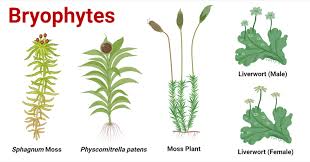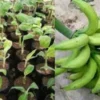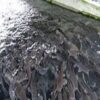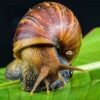In previous articles, the study has focused on algae in general. This article introduces the Bryophytes.
Bryophytes are considered to be the first land plants among embryophytes. The exact details of their transition to land remain unclear due to incomplete fossil records.
The characteristic features of each group are described here, along with a few genera that belong to these groups. Comparisons are made between these genera and the more commonly recognized flowering plants.
General Characteristics of Bryophytes
The Division Bryophyta includes the simplest and most primitive members of land plants, which lack roots and do not have a vascular system. Some mosses, however, have a primitive system of tubes that conduct water and food.
The water-conducting tubes are called hydroids, which are elongated, thick-walled, dead cells but are not lignified like tracheids and vessels. The food-conducting tubes are called leptoids, connected through plasmodesmata.
A single bryophyte plant is very small, typically only a few centimeters in size, and rarely grows large due to the lack of supporting tissues. Thousands of tiny moss plants often grow together, giving a thick, green carpet-like appearance. The morphology of some common bryophytes is described in detail.
Bryophytes exhibit two distinct and well-defined phases of their life cycle: sexual and asexual, which alternate. The gametophyte is haploid and produces gametes, while the sporophyte is diploid and produces spores.
The haploid generation alternates with the diploid generation, much like in algae. Both the gametophyte and sporophyte may be several centimeters long, but the gametophyte is the dominant phase of the life cycle. This is different from other land plants, where the sporophyte is dominant.
The gametophyte may be thalloid or have an axis differentiated into stem-like and leaf-like structures that lack xylem and phloem. These leaf-like structures belong to the gametophyte, unlike vascular plants, where leaves develop on the sporophyte.
The gametophyte is green, photosynthetic, nutritionally independent, and anchors to the soil via unicellular or multicellular filaments called rhizoids. Rhizoids resemble roots but lack vascular tissues and are simpler in structure.
Bryophytes thrive in moist tropical areas but can also grow in deserts, mountains, and parts of Antarctica. In drier regions, their growth is limited to wet seasons. Some mosses grow in freshwater streams, though they are absent in sea flora.
Read Also: How often you need to Change Water in your Fish Farm
Life Cycle of Bryophytes
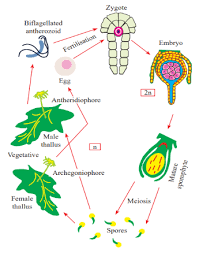
The life cycle of bryophytes is exemplified here using Funaria. The gametophyte of Funaria bears two types of specialized multicellular reproductive organs called gametangia, which protect the egg and sperm during development.
The male gametangia, known as antheridia (singular: antheridium), produce sperm, while the female gametangia, known as archegonia (singular: archegonium), produce eggs. Both gametangia have an outer sterile layer of cells forming a protective jacket.
Bryophytes are oogamous, meaning the egg is larger, non-flagellated, and non-motile, while the sperm is smaller and motile.
After fertilization, the sporophyte begins developing inside the archegonium. It may grow several centimeters long and become photosynthetically sufficient, but it relies on the gametophyte for water and minerals. Unlike the sporophytes of other land plants, it never becomes fully independent of the gametophyte.
It remains attached to the gametophyte throughout its life cycle and is partially dependent on it for nutrition. The mature sporophyte consists of a haustorial foot, a stem-like seta, and a terminal spore-producing capsule.
In some bryophytes, such as Riccia, both foot and seta are absent, while in others like Sphagnum, the seta is absent. Within the capsule, spores are produced through the reduction division of spore mother cells.
Bryophytes are homosporous, meaning they produce only one type of spore, unlike some pteridophytes, which are heterosporous and produce both microspores and megaspores.
A spore represents the first stage of the gametophytic generation. It is unicellular, haploid, and germinates to produce a short-lived green protonema. The adult gametophore develops on this protonema, which may be thalloid, globular, or filamentous. The protonema and the adult gametophore differ significantly from each other.
An adult gametophyte bears gametangia that produce haploid male and female gametes. These gametes represent the final stage of the gametophytic generation, while the zygote represents the first stage of the sporophytic generation.
The spore mother cells, which are diploid, represent the last stage of the sporophytic generation. The spore mother cells undergo reduction division to form haploid spores. Thus, any stage in the life cycle that is haploid belongs to the gametophytic generation, while the diploid stages belong to the sporophytic generation.
Morphology of Bryophytes
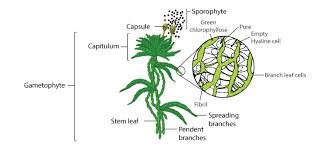
Bryophytes are non-vascular plants that represent the simplest and most primitive land plants. Based on their morphological and anatomical characteristics, the Bryophyta division is divided into three main classes: Hepaticopsida (liverworts), Anthocerotopsida (hornworts), and Bryopsida (mosses). This summary outlines key genera within each class, providing an understanding of their structure, habitat, and features.
1. Hepaticopsida (Liverworts)
Liverworts typically grow close to the ground, either as thalloid or leafy forms. In thalloid liverworts, the gametophyte is dorsi-ventral, meaning it has distinct upper and lower surfaces. Leafy liverworts have leaf-like structures, but their leaves lack a midrib. Internally, liverworts can be homogenous or made up of different tissue types.
i. Riccia
Family: Ricciaceae
Distribution: Over 130 species, found on moist soil and rocks.
Structure: Thalloid, green, fleshy gametophyte with dichotomous branching, forming circular rosette-like patches. Male and female organs may be present on the same or separate thalli.
Special Features: Rhizoids (smooth-walled or tuberculate) attach the thallus to the substratum. Scales protect the growing point from desiccation.
ii. Marchantia
Family: Marchantiaceae
Distribution: Found in cool, moist places.
Structure: Prostrate, dorsi-ventral, dichotomously branched thallus with a midrib and gemma cups (structures containing gemmae for vegetative reproduction). Archegonia (female organs) and antheridia (male organs) are present on stalked structures called archegoniophores and antheridiophores, respectively.
Special Features: Dioecious, with distinct hexagonal markings on the thallus surface, and rhizoids and scales for attachment.
Read Also: Benefits of Constructing a Fish Pond with Tarpaulin and Woods
2. Anthocerotopsida (Hornworts)
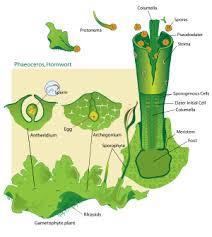
The class Anthocerotopsida is represented by a single order, Anthocerotales, and includes around 200 species.
i. Anthoceros
Family: Anthocerotaceae
Habitat: Grows in moist shady places, such as ditches and cracks in rocks.
Structure: Dorsi-ventral thallose gametophyte, sometimes dichotomously branched. The thallus is dark green and lacks a distinct midrib. Rhizoids are smooth-walled, without scales or tuberculations.
Special Features: The thallus is velvety, and the sporophyte emerges from a basal sheath on the thallus surface.
3. Bryopsida (Mosses)
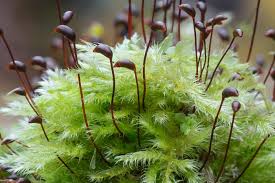
Bryopsida is the largest class of bryophytes, with around 600 genera and 14,500 species. It is divided into three subclasses: Sphagnidae (peat mosses), Andreaeidae (rock mosses), and Bryidae (true mosses).
i. Sphagnum
Family: Sphagnaceae
Habitat: Found in acidic, water-logged areas, forming peat bogs.
Structure: Upright leafy shoot (gametophores) developed from a thallose protonema. Leaves lack midribs and consist of two types of cells: chlorophyllous cells for photosynthesis and hyaline cells for water absorption.
Special Features: The ability to hold large quantities of water makes Sphagnum vital for bog formation and useful in horticulture. Hyaline cells with pores and spiral thickenings aid in water retention and cation exchange, creating an acidic environment.
ii. Funaria
Family: Funariaceae
Distribution: Cosmopolitan, with Funaria hygrometrica being the most widespread species.
Structure: Erect gametophore with spirally arranged leaves. The gametophore develops from a filamentous protonema. Rhizoids anchor the plant to the substratum. The sporophyte consists of a foot, seta, and capsule.
Special Features: The leaf midrib is distinct, and the protonema plays a significant role in the gametophyte’s development.
In conclusion, Bryophytes are non-vascular plants that exhibit a unique life cycle with alternation between the gametophyte (dominant generation) and the sporophyte.
The three major classes of bryophytes, Hepaticopsida, Anthocerotopsida, and Bryopsida, show diverse morphological adaptations to their environments.
These adaptations include structures for vegetative reproduction, water absorption, and protection from desiccation, making bryophytes well-suited for their typical moist habitats.
Do you have any questions, suggestions, or contributions? If so, please feel free to use the comment box below to share your thoughts. We also encourage you to kindly share this information with others who might benefit from it. Since we can’t reach everyone at once, we truly appreciate your help in spreading the word. Thank you so much for your support and for sharing!

